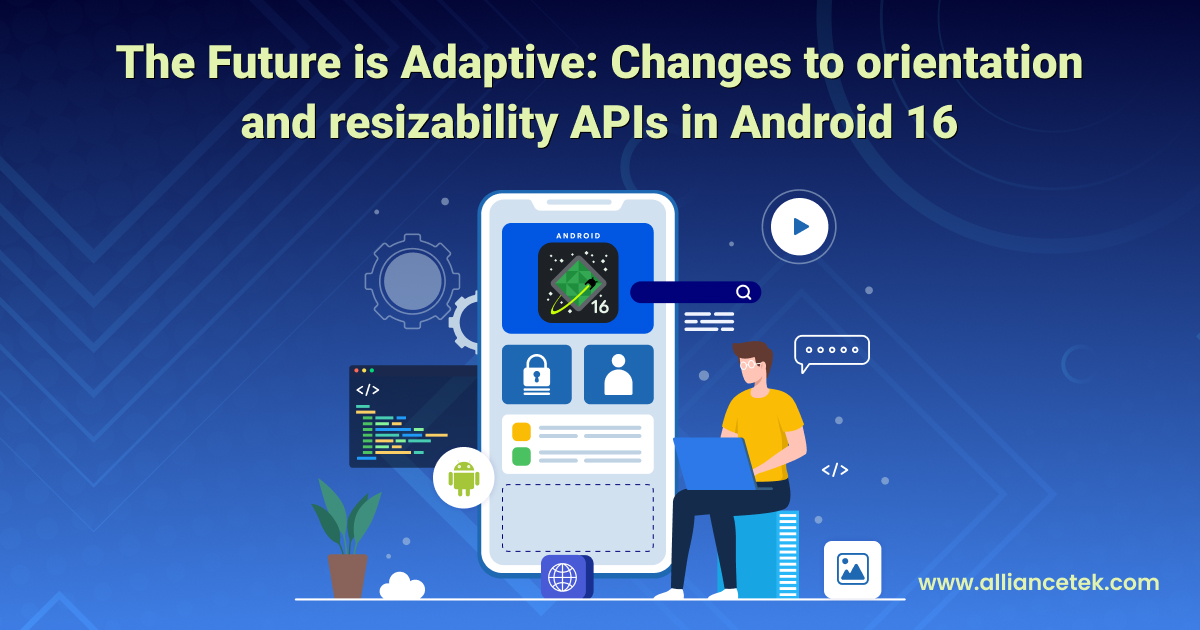You might have created Android applications that presuppose a fixed orientation or restrict the ability of users to resize windows. Perhaps you locked your app in portrait mode, or disabled resizing on tablets or foldable. Android 16 changes that. It renders adaptive behaviour as normal. When your application is aimed at Android 16 (API level 36), certain restrictions will be bypassed on large screens. Now you will have to make changes to make your application work everywhere. This is just as important as planning for custom mobile app development services in today’s ecosystem.
Table of Contents
Why Android 16 Is Shifting the Way Apps Process Orientation and Window Size
Android users can now run applications on a wide variety of devices, phones, foldables, tablets, Chromebooks, even cars or XR devices. They anticipate the apps to act properly when they switch their orientation or when the app window becomes larger or smaller. An app that does not rotate or resize is stiff. It is detrimental to usability and may be frustrating to users. The same expectation exists when companies invest in mobile app solutions or broader mobile solutions.
Google realized this and therefore amended this system to make it more uniform. In most instances, Android 16 will eliminate the capability of apps to limit orientation and resizability on the platform level. It implies that certain manifest settings or runtime API calls that previously enforced fixed sizes or locked orientations are no longer going to work on large screens.
Android desires apps to be automatically adjusted, much like businesses expect from mobile application development services and mobile app deployment strategies. Many teams also depend on mobile app consulting services to adjust their approach to these shifts.
What Android 16 Is Changing in Particular?
In case your application is aimed at Android 16, the following are the changes in behavior that you must be aware of. These are used on large screen devices, i.e., displays with the smallest side of approximately 600dp or greater. These are the same platforms where businesses often hire mobile app developers or hire mobile application developers to ensure their software adapts well.

But there are exceptions:
- If the screen is smaller than 600dp, these changes don’t take effect.
- Games are exempt, by way of the app’s category flags.
- Users can sometimes opt in to let the app keep its own behavior for aspect ratio via system settings.
Also, there is a temporary opt-out flag: if your app isn’t ready, you can set a manifest property to delay the change for now. But that opt-out will disappear when your app needs to target a future Android version (e.g., Android 17 / API level 37). This is where companies may choose to hire dedicated mobile app developers to handle the transition smoothly.
How You Need to Prepare Your App?
These are feasible steps that you can take, or hire the best mobile app developers, to prevent breaking behavior or surprising users.
- Check all layouts, portrait and landscape. When changing the orientation or window size, there might be elements that appear stretched or off-screen when your UI was designed only to support a portrait orientation.
- Apply a responsive/adaptive layout. As an example, limit the width of scrollable containers to ensure that the content is not lost when the size is small or tall.
- Maintain UI state during configuration changes (e.g., on orientation change or window resize). When your activity restarts, you should save and restore such things as form input or scroll position.
- Test on big screen devices or emulators: tablets, foldables, Chromebooks. Android Studio has preview tools that can be used to visualize the behavior of the UI as the window size varies.
- Test behavior early with compatibility or flags tools: e.g., the UNIVERSAL_RESIZABLE_BY_DEFAULT flag.
- Gradually remove dependencies on orientation locks and fixed aspect ratio values. Refactor code where setRequestedOrientation() or manifest screen orientation attributes were used heavily.
These steps echo the same mindset needed in cross-platform mobile app development and enterprise mobile application solutions, where flexibility and scalability drive success.
Potential Problems You Could Encounter
In the implementation of adaptive behavior, certain issues might arise. They will help you have an easier time migrating. Developers often consult mobile app launch strategy playbooks or rely on custom mobile software consulting partners to anticipate such risks.
- UI overlap or content truncation: UI elements that are oriented to a single orientation can fail when the orientation changes.
- Performance problems: When orientation or size is changed, activity recreation may lead to lag or visual pop.
- Visual stretching: Visual objects or elements that require constant aspect ratios can appear stretched or distorted.
- State loss: When the state is not maintained correctly, the users can lose the typed or scrolled information.
- Test edge-cases: Foldables unfolding/unfolding, desktop mode window resizing, and multi-window splits. Any situation may lead to unanticipated layout behavior.
These are also common considerations in mobile application support and maintenance, where the focus is on ensuring stability across updates and changes.
Conclusion
Get your app ready now. Android 16, test both orientations, and eliminate the use of hard orientation or aspect ratio locks wherever feasible. The opt-out manifest flags are to be used as short-term instruments. Ensure that your UI can support the resizing of windows or a change in screen dimensions. Often, teams bring in experts, such as hiring top mobile app developers or hiring mobile app programmers for this stage.
When you make your app flexible, your tablet, foldable, Chromebook, or big screen users will enjoy it. Your application will be more contemporary. It might be hard work, but it’s worthwhile for your future. For many, this may involve bringing in expert mobile app developers or hiring remote mobile app developers to add specialized skills, such as those from AllianceTek.











